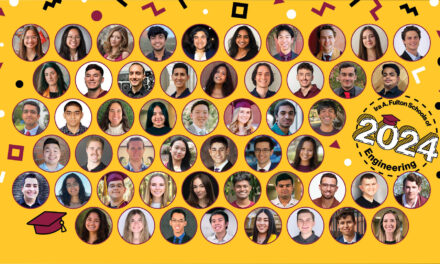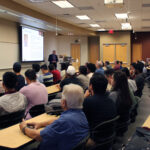
ASU water visualization tool recognized for sustainable impact
NASA-funded Long-Range Scenario Modeling of the Colorado River Basin project earns Governor’s Award for Arizona’s Future

Water from the Colorado River Basin which spans 250,000 square miles of the Southwest from Colorado to the Gulf of California, is essential to seven states: Arizona, California, Colorado, Nevada, New Mexico, Utah and Wyoming. A nationwide drought has made the use of that water a highly contested and controversial topic. States, cities, counties and tribal communities dispute how use of the water should be shared and managed.
An Arizona State University research team has been developing solutions to help decision-makers manage this precious resource. In 2019, the NASA’s Earth Science Division awarded the Center for Hydrologic Innovations at Arizona State University a $1 million grant for its Long-Range Scenario Modeling of the Colorado River Basin project.
In collaboration with the Central Arizona Project, or CAP, and 14 other water management agencies, ASU’s team of researchers developed an online visualization tool, CRB-Scenario-Explorer, which can simulate scenarios like droughts and forest disturbances. With the ability to determine the outcomes of these scenarios, the tool enables users to explore and understand the impact of climate change on the Colorado River Basin.
“Information is power,” says Enrique Vivoni, of civil, sustainable and environmental engineering in the Ira A. Fulton Schools of Engineering at Arizona State University and director of the Center for Hydrologic Innovations. “We’ve created an online tool that is free to use and is designed with a user in mind to encourage exploration. Anybody can use it.”
Vivoni says the most difficult part of the project is that conditions are constantly changing in the basin, requiring a quicker response from decision-makers.
“Agencies who have a stake in the Colorado River Basin are not necessarily in agreement about changes in policy,” says Vivoni, a faculty member in the School of Sustainable Engineering and the Built Environment. “As a result, decision-makers are seeking unbiased information, data and models from universities and other research organizations that can help them in the difficult tasks that lie ahead. Our challenge is to provide outcomes that are clear, actionable and communicate the uncertainties involved.”
For this reason, Vivoni says it was important for the team to collaborate with various organizations across states to ensure the project’s outcomes and models accurately represented the diverse perspectives of the basin.
He emphasizes the importance of recognizing the collective effort behind this project and that its success was achieved through the collaboration of researchers, students and stakeholders. This means the project’s impact extends beyond the boundaries of Arizona and can serve as an example for water initiatives across the country.
Recently, the project received the Governor’s Award for Arizona’s Future from the environmental organization Arizona Forward, a recognition given to projects with significant sustainability impacts. Vivoni says that the award is a testament to the project’s ability to provide policymakers with valuable insights to guide water resource management.
“The work of Vivoni and his team exemplifies the type of use-inspired research we seek to advance as we develop solutions to real-world challenges,” says Ram Pendyala, director of the School of Sustainable Engineering and the Built Environment. “Congratulations to the team for this impactful work, which will help address one of the biggest issues confronting the Southwest—the future of water.”
Future improvements to the project will include updating the water visualization tool so that it auto-populates with real-time data and modeling information from NASA and other agencies.
“What we have developed to date is a static tool that visualizes a set of far future scenarios,” Vivoni says. “We are now working on a more dynamic web-based platform that will be capable of monitoring current conditions and forecasting the near future. For example, we could find out from the tool what the state of the Colorado River Basin is now and what the water projection is in the next year.”
As Arizona faces mounting water resource challenges, leaders of the simulation project hope to continue bringing together scientific expertise, engagement with decision-makers and innovative modeling techniques.
“The future will be more challenging,” Vivoni says. “There will likely be less water due to warming temperatures and the loss of snow cover. This use-inspired research comes from a real need for Western states to rethink how they use water now and in the future. We also must think about equity. Equity comes in all shapes and forms. It’s not only about water for the most important economic output, it’s about water fairness as well.”



































